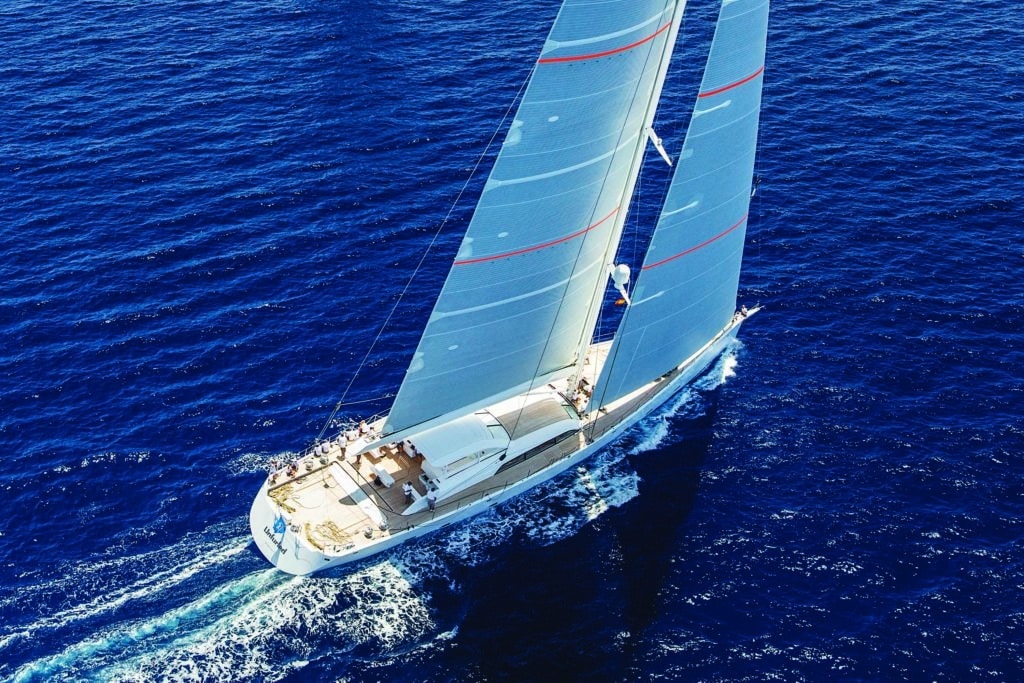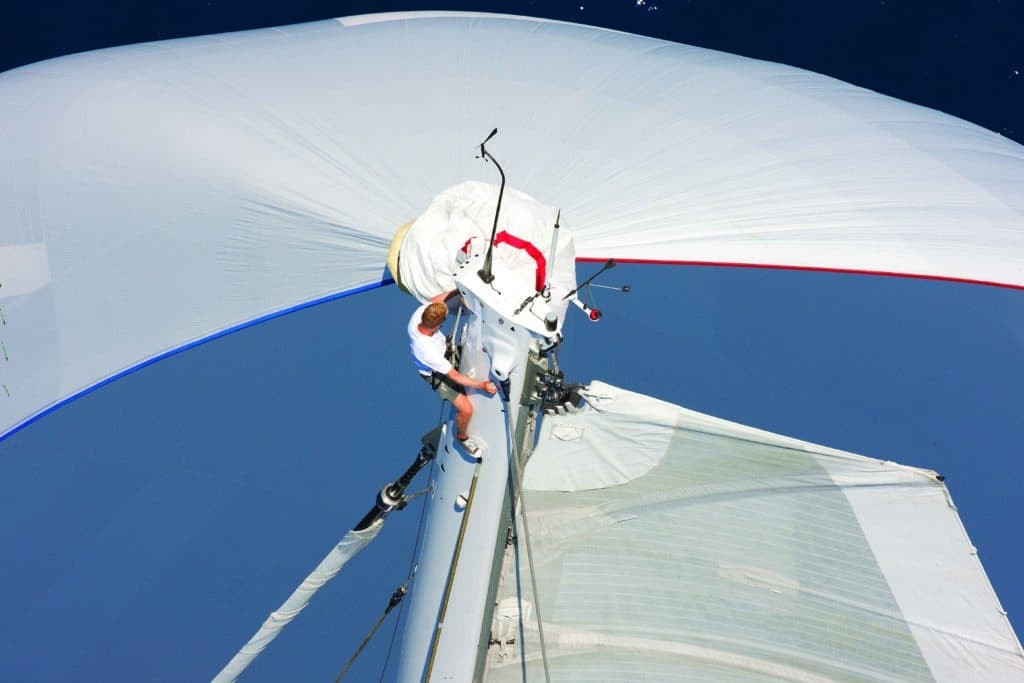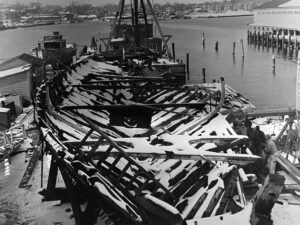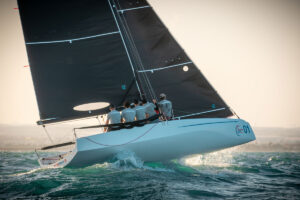
It’s impossible to appreciate the marvel of a superyacht until you see one up close. It’s breathtaking to watch one charge by under full sails that are spoken of in acres rather than square feet. These sail packages, and the highly engineered hardware that controls them, are truly the engines that are turning these multimillion-dollar ocean liners into grand-prix machines.
Composites, carbon rigs, 70-ton captive winches the size of small automobiles, and hydraulic advances have all contributed to the acceleration of superyacht racing. In lockstep have been the wardrobes, blends of best-available aramids and carbon. But when it comes to the sail inventories, there is one limiting factor: sailhandling. Sure, you can make the sails bigger, but there’s only so much a boat and its crew can handle.
What is the limit? As the guy who has delivered a few of the biggest superyacht sails ever made, Robbie Doyle has been asked this very question many times. “How big a sail can we build? It’s an open question,” he says. Take, for example, the 195-foot Perini Navi Perseus3. The owner had clear intentions of making it a racing boat. “So we built the largest spinnaker ever built,” Doyle says. At 27,835 square feet, the A2 is about half an acre of cloth. “It weighs 1,000 pounds, but we had to jump through hoops to get it light enough to be movable by eight people. The challenges of these sails are huge.”
The sails are expensive, too, says Scott Zebny, of North Sails, who’s worked the superyacht scene for decades. His current client is the keen and experienced American owner of the 151-foot Unfurled, a top-shelf program that has pioneered a few of the latest sailhandling systems.
Unfurled, says Zebny, is the first superyacht its size to use in-boom furling with a square-top mainsail, which itself is new territory. The challenge of stowing Unfurled’s massive head panel, with its gaff batten and big bits of hardware, was solved by the sailors. In collaboration with Southern Spars, the team developed a system that requires only two crewmembers to hook up or stow the headboard car. “It looks really simple,” says Zebny, “but it was a daunting task to make it easy to use.” An obvious drawback, not lost on Zebny, is that square-top mainsails require split backstays. The team developed a system that quickly and reliably tensions one and eases the other during a jibe. “It’s like a captive reel that pulls a bullet into the lock quickly, and the last bit [of tensioning] is done with a hydraulic ram,” he says. “You really have to have that right, or you get yourself in trouble.”
By trouble, he means toppling nearly 200 feet of carbon craftsmanship, which is something boat captains don’t appreciate. “One thing to keep in mind with these monsters is keeping efficient sail plans,” says Doyle, who wrestles with owner demands for bigger sails. “So much of the boat becomes inefficient. You can’t keep making up for the inefficiencies by going bigger and bigger to the point where it gets too big.”
Developing inventories for superyachts is a much different experience today than it was in the time of sailmakers who fitted to the build after the fact. Zebny and his North Sails colleague Jens Christensen say sailmakers play a much more active role today. The noticeable result in venues like Palma and St. Barts is the boats being pushed closer to their potential. As big-boat racing programs have died over the past 10 years, the pool of experienced sailors has become very deep. At every superyacht regatta, rock stars past and present populate the crew lists, bringing up the collective skills of the owners and their regular mates.
It’s also now standard procedure to be involved in a new build from the outset, says Zebny, taking into account how an owner really intends to sail the boat, what kind of inventory the full-time crew can manage, and making sure the deck layout fits the sails. There’s a hard balance between cruising intentions and the big regattas. They say it’s not about the results, but who are they kidding?
“With the captive winches, you don’t have any flogging sheets on deck, which is dangerous,” says Dana Jennings, custom sales project manager for Harken. “Everything is hidden but still highly loaded. In my world, 100,000-pound loads are peanuts. Take hydraulic jib leads — all they care about nowadays is getting the clew right down to the deck.”
Regatta organizers are getting better at putting like boats together on the racecourse, says Christensen, who works with Hasso Plattner’s 147-footer, Visione. “The designers are pushing owners to go racing and pushing the skippers to better understand what the boat can truly do. When they get experienced sailors on the boat, they help push it to its potential. It’s a pity, for the owner and for the crew as well, to spend millions of dollars on a boat and not sail it well.”

Zebny says progress has been made at the shipyards, too, where hydraulic packages now allow the boats to be sailed more efficiently in stronger winds. “Until the last five years, you couldn’t sail a new boat in 20 knots because the gearing wasn’t up to it,” he says. “Unfurled is huge and we often sail it around the course like a 40-footer — well, almost.”
Sailmaking and materials have advanced as well, to the point where programs no longer need two separate inventories for racing and cruising, which was once a barrier for owners less keen to race. Pre-regatta and sail shuffles aren’t as they would be at big-boat grand-prix events.
North Sails’ more durable 3Di cloth allows programs like Unfurled to have a single mainsail and only two jibs (“A big one and a little one,” says Zebny.). Doyle Sailmakers’ Stratis and ICE offerings were developed to address durability but also weight and practicality. One tandem development has been the refinement of furling carbon jib battens, manufactured by C-Tech of New Zealand. Battens allow for extra roach in the non-overlapping jibs.
“In the old days, you’d have to have a ton of leech hollow on a 100 percent jib to support itself,” says Zebny. “Now we just build it with a straight leech, stick these battens on there, and it makes a better-performing sail.”
Still, leech-shape control remains an issue, and here, too, embedded pro sailors have devised a solution. A typical leech cord could be 150 feet or longer, and tightening it merely takes the stretch out of the cord. If the wind goes light, the leech line recoils when it’s eased, resulting in excessive hook in the back of the sail. Then, when the sail is furled, the hook creates compression; the sail puckers on itself and creates folds, which become cracks; and the sail wears out faster. Smart Rigging’s solution, says Zebny, is a PBO sling similar to what you’d see on a furling cable or a shroud. It’s expensive, but with less stretch, there’s less recoil. Add in the furling leech battens, and flutter is a nonissue.
One obstacle come race day, however, is deciding which jib to have on deck. Moving a half-ton brick of sail from below requires more than a bunch of big, strong men. On Unfurled, they use a halyard to extract what they need from the tender locker underneath the teak foredeck.
To manage sails kept on furlers, they have a solution adopted from the commercial fishing industry: giant take-up spools. Beneath a small hatch on the foredeck are two 6-foot-diameter drums, around which furled downwind sails are stored. A halyard is connected to the top of the cable and hoisted as the drum unwinds. A crewmember can eventually walk the tack forward and attach it to a furler on the bow. The cable is then tensioned to get the sail on the halyard lock.
“Big furling sails are now easily handled by two people instead of having a big bag on the deck that weighs 500 kilos and requires six people to deal with it,” says Zebny. Cable manufacturers also like the spool system, says Christensen, because the cables aren’t forced into tight-radius bends that result when furled sails are snaked into deck bags.
Upwind sails require minimal manhandling once in place while racing, but the hoisting and dousing of downwind sails are what give boat captains great anxiety. The spinnakers especially are massive, says Zebny. “There are smaller 110-footers that are just dropping spinnakers right to the deck. We wouldn’t have done that 10 years ago, but the crews today are better,” he explains. “Still, it doesn’t matter how many minions you throw at it. If it gets into the water, you’ll never get it back.”
Spinnaker snuffers are therefore the most reliable option, and C-Tech makes the most widely used inflatable units. “Typically, we start the day with the snuffer at the head of the sail and use the new zipper systems,” says Zebny. “[On Unfurled] we hoist the sail zipped, so the first set is a normal set. The only real tricky part is getting the snuffer under the foot of the jib out and over the lifelines. The drop is just an all-hands-on-deck gather. On some boats, once the team is settled, they basically pull the head out, pull the sail out of the sock, zip it up, and repack it again on deck. On Unfurled, we’ve just gotten good with bucket-down hoists.”
Such improvements and confidence in containing the sails are perfect examples of the benefits that the proliferation of pro sailors has brought into superyacht racing, says Christensen. “They figure out how to do stuff and show the crew how to get the sail up and down better. It’s the little things here and there with these guys [that] help crew to improve the handling on the boat, which then doesn’t scare the crew to hoist the spinnaker when the boss is cruising,” he says.
That’s what gets the owner more value out of his boat, he adds, and keeps him coming back for more and possibly even going bigger and faster. Good or bad, says Doyle, the racing is more pro-driven than ever before, as is the sailhandling. “The actions taken to get around the course faster, whether it’s close-reaching with spinnakers, hoists and takedowns at the last minute — all those things are not something an amateur crew can do consistently, safely,” he says. “Many owners start out with mainly friends in the crew, but the progression ends up being mostly to pros. We’re now at the point where we have boats being built exclusively to win the Buckets, and they have the crews to make these machines go.”









